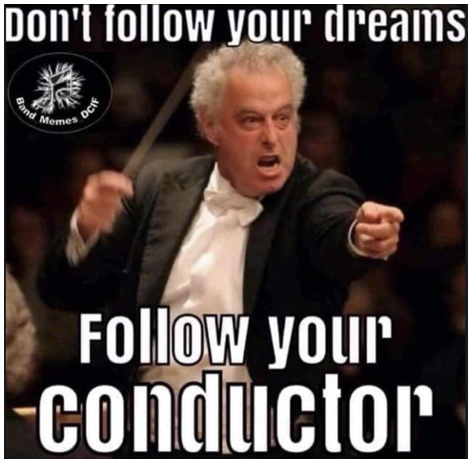«IF I TELL THE BERLINERS TO STEP FORWARD, THEY DO IT.» – by Lea Vaterlaus
Art/Music
REMEMBER KARAJAN?
Every orchestra musician knows at least one example of a true ‘old school’ conductor. One doesn’t necessarily have to go back as far as Herbert von Karajan and his Berlin Philharmonic to find pretty archaic relationships between conductors and orchestras. But how do conductors establish their leading position amongst a group of up to 120 musicians?
SOME THEORY ON THE SUBJECT
Sociolinguists call the (positive) value a person claims for themselves during a particular interaction ‘face’ (yes, they DO have a theoretical term for every possible communication feature). The basis for the conductor’s leading position is thus the awareness of their own role and the musicians’ inclination to accept that. But how does the English language come into that and what features play into the establishment of power?
Again, there is a term for the unequal distribution of (linguistic) power in interactions: Asymmetric Power. Who talks more? Who interrupts? Who addresses the interlocutors directly?
IN THE REHEARSAL…
I wanted to investigate the relationship between a professional orchestra and their conductor myself and thus visited the rehearsal of a local orchestra with about 100 professional musicians of very diverse nationalities and ages. Due to the internationality of the orchestra, English is mostly the chosen language during rehearsals.
The situation was a special one: Only one day before, the designated conductor for the upcoming concert took ill and a new conductor had to be found at once. Due to the necessary replacement and straightforward commitment, the new conductor thus already had the advantage of being in a favourable position.
The beginning of the rehearsal, however, was unconventional: The conductor hurried in about 20 minutes late and the concert master – the second instance of power in the orchestra – took over for the first few minutes. As soon as conductor xx arrived, however, the power was redistributed the moment he stepped on the platform in the middle of the orchestra. One has to mention at this stage, that the new conductor was young, very colloquial and unconventionally dynamic – contradicting many prejudices against his profession. His techniques are unconventional, too: He ran on and off the stage every now and then to test the acoustics in the music hall and to listen to the orchestra play on its own, and in one instance compared a section of the rehearsed symphony to an oriental song on his mobile phone.
FOLLOW YOUR CONDUCTOR!
The distribution of power, however, was still asymmetric: the conductor was the one to commence, disrupt and stop the rehearsal, he was the one to talk the most and to address some musicians directly (remember Sergiu Celibidache and his infamous roasting of the viola section)?
Noticeable were some other features: humour and the asking for confirmation. Every now and then, conductor xx cracked a joke or sought the approval from the orchestra. Of course, humour can be seen as a leadership feature, making sure that everyone in the orchestra is comfortable.
Linguistically, the conductor used terms such as “Alright”, “You good” or “Ok”? And even though the questions might at some points be simply rhetorical, it is obvious that he appreciated the orchestra’s agreement on his musical propositions. His tone was kind but determined, making sure that everyone still follows his instructions.
HAVE MERCY WITH THE CONDUCTORS
So, as you can tell, the establishment of the conductor’s ‘face’ is still crucial in modern day orchestras. Even though power relationships might vary and the boundaries between musician and conductor might become more dispersed, it is important for the figure with the baton to hold together the huge bunch of musicians during rehearsals and concerts. Else, what would happen to a 100-person orchestra without leadership…?
by Lea Vaterlaus